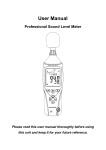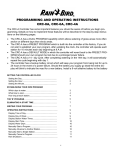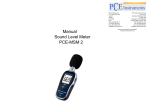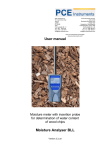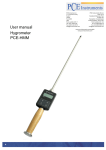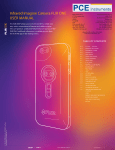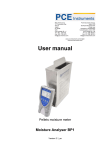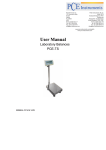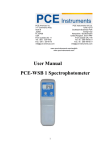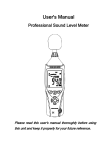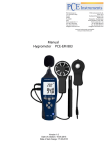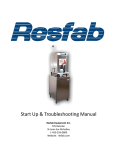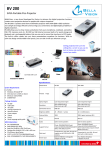Download User`s Manual - PCE Instruments
Transcript
User's Manual Sound Level Meter PCE-322A PCE Americas Inc. 711 Commerce Way Suite 8 Jupiter FL-33458 USA From outside US: +1 Tel: (561) 320-9162 Fax: (561) 320-9176 [email protected] PCE Instruments UK Ltd. Units 12/13 Southpoint Business Park Ensign way Hampshire / Southampton United Kingdom, SO31 4RF From outside UK: +44 Tel: (0) 2380 98703 0 Fax: (0) 2380 98703 9 [email protected] www.pce-instruments.com/english www.pce-instruments.com Please read this user's manual thoroughly before using this unit and keep it properly for your future reference. Contents 1. Safety.......................................................................... 1 2. General description..................................................... 2 3. Specifications ............................................................. 3 4. Meter description........................................................ 5 5. LCD display description ............................................. 7 6. Operation instruction .................................................. 8 7. Calibration procedure ............................................... 14 8. Basic operation ......................................................... 15 9. Operating procedures ............................................... 16 10. Software installation ............................................... 17 11. Software interface introduction .............................. 18 12. Operation ................................................................ 24 13. Notes....................................................................... 26 14. Accessories ............................................................. 27 1. Safety Read the following safety information carefully before attempting to operate or service the meter. Use the meter only as specified in this manual; otherwise, the protection provided by the meter may be impaired. ◆Environment conditions: Altitude up to 2000 meters RH≤90%(Non-Condensation) Operating Temperature: -20~60℃ ◆Maintenance Repairs or servicing not covered in this manual should only be performed by qualified personnel. Wipe the unit with a dry soft cloth. Do not use abrasives or solvents on this instrument. ◆Safety Symbol Comply with EMC 1 2. General description This Sound Level Meter is designed to meet the measurement requirements of safety Engineers, Health, Industrial safety offices and sound quality control in various environments like construction, factories, schools, offices, traffic access, household, stereos, etc. ◆Comply with IEC61672-1 CLASS2 standard ◆Max/Min record ◆Over range indication ◆Under range indication ◆Time, data transmission display ◆A & C Weighting ◆Selectable response time: FAST/SLOW ◆Analog AC/DC outputs for connection to frequency analyzer or X-Y shaft recorder ◆PC real-time monitoring, recording and memory ◆4digits LCD display with a resolution of 0.1dB ◆Sampling time: 2 times/second. 3. Specifications Applied standard IEC61672-1 CLASS2 Accuracy ±1.4dB Frequency range 31.5Hz~8kHz Dynamic range 50dB Lo:30dB~80dB Measuring level Med:50dB~100dB range Hi: 80dB~130dB Auto:30dB~130dB Frequency weighting A&C Time weighting: FAST 125ms;SLOW ( 1s ) Microphone 1/2 inch electret condenser microphone Display 4digits LCD display with a resolution of 0.1dB Sampling time 2 times/sec Max Hold MAX Min Hold MIN HOLD: Hold the readings “OVER”is when input is more than upper Alarm function limit of range. “UNDER”is when input is less than lower limit of range. AC/DC Analog output outputs from earphone outlet AC=1Vrms ,DC=10mV/dB Meter memory: 262100 readings PC monitors and records in real-time, each Data recording: Auto power off Power supply Battery life Operating conditions Storage conditions Dimension (L*W*H) Weight: 15,000 readings will be saved one time automatically. Meter automatically shuts down after approx. 15 minutes inactivity. One 9V battery, 006P or IEC 6F22 or NEDA 1604. at least 30 hours -20~60℃; 10%RH~90%RH -20℃~60℃; 10%RH~75%RH 252*66 *33 mm 262g 4. Meter description ①Windscreen microphone cover ②Metal Rod ③LCD display ④Frequency weighting A/C selection key ⑤Backlight ON/OFF key ⑥HOLD key ⑦Range selection key ⑧Power ON/OFF key ⑨MAX/MIN key ⑩Response time selection key ⑪SET key ⑫Potentiometer calibration ⑬AC/DC signal output earphone outlet ⑭USB interface ⑮External DC 9V power supply terminal ⑯Dustproof cover ⑰Tripod nut ⑱Battery Compartment 5. LCD display description Icon Function LCD 4 digits MAX Maximum data hold MIN Minimum data hold OVER Input value is more than upper limit of range. UNDER Input value is less than lower limit of range. FAST Fast response SLOW Slow response dBA A frequency weighting(the noise that human ear can hear) dBC C frequency weighting (response to machine monitor) 88 ~188 Range display TIME Display current time(Hour-Minute-Second) DATE Display current date(Year-Month-Day) AUTO Auto level range selection HOLD Data hold function REC Data recording Full Memory is up to limitation Auto power off Low battery indication Real-time communication icon: it flashes when the meter is connected with PC to achieve data transmission. 6. Operation instruction (1) Frequency weighting selection: Press " " key to select A or C. (2) Backlit: After turning the meter on, momentarily press " " key, the backlit will be on/off, it will automatically turn off after approx. 30 seconds of inactivity. (3) HOLD: After turning the meter on, momentarily press " " button, "HOLD" icon will appear on the LCD, which indicates the data is freezed. To release the held reading, press the button again. (4) Level range selection: Press “ ” key, the level range will change from ‘Lo’, ‘Med’, ‘Hi’ to ‘Auto’ level circularly. (5) Power on/off: " key for 1 second to turn on the meter, while keep Press the" pressing it for approx. 3 seconds, the meter will be off. (6) MAX/MIN Press the " " key for one time to enter MAX/MIN measurement, ‘MAX’ will appear on LCD, the captured maximum sound level will be displayed on the LCD. Press the key again, ‘MIN’ will appear on LCD and minimum sound level will be displayed on the LCD. Press the button one more time to exit MAX/MIN measurement mode. (7) FAST/SLOW Press “ ” to select FAST or SLOW time weighting measurement. FAST: Fast sampling measurement, 1 time per 125ms. SLOW: Slow sampling measurement, 1 time per second. (8) Date & Time Set (8.1) Keep pressing the " " key before power the meter on, then power the meter on and release this key when the DATE icon and data flash,enter into the Date & Time Set mode, the display will be YEAR-MONTH-DAY, see fig. as below: When the YEAR data flashes continuously, press "▲" key to increase the value and press the "▼" key to decrease the value.See fig.as below: Press " " the second time, the MONTH data will flash continuously, then press “▲” or “▼” to increase or decrease the value. See fig. as below: Press " " the third time, the DAY data will flash continuously, then press "▲" or "▼" to increase or decrease the value. See fig.as below: Press " " the fourth time, the TIME icon and HOUR data flash, then press "▲" or "▼" to increase or decrease the value. See fig.as below: Press " " the fifth time, the MINUTE data flash, then press “▲” or “▼” to increase or decrease the value. See fig.as below: After finish the Date & Time set, press "PEAK" key to save the data and exit this mode. (8.2 )TIME/DATE Display After power the meter on, press " " key one time to convert TIME or DATE display. (8.3) REC recording function Keep pressing the "REC" key for 3 seconds until "REC" icon appears on LCD, then the meter will start recording automatically according to the set sampling rate. When the memory is up to limitation, "Full" icon will appear on LCD and the meter stop recording automatically. The meter will restart recording after the memory data is cleared up. During recording, keep pressing the "REC" key for 3 seconds will exit recording mode. Note: External power supply must be connected for long-time recording to avoid the meter shut down suddenly and the recorded data lost. (9) AC/DC Signal Output Earphone Outlet AC: Output voltage: 1Vrms corresponding to each range step. Output impedance: 100Ω DC: Output voltage: 10mv/dB Output impedance:approx.1KΩ (10) External power supply: DC 9V input External DC 9V, positive inside and negative outside Pore size:OD 3.5mm, ID 1.35mm 7. Calibration procedure (1) Make the following switch settings: a) Frequency weighting: A-weighting b) Time weigh tin g: FAST c) Level ran ge: 5 0 ~100dB (2) Insert the microphone housing carefully into the 1/2 inch insertion hole of the calibrator(94dB @ 1kHZ). (3) Turn on the switch of calibrator and adjust the CALL potentiometer until 94.0dB is displayed. NOTE: This meter has already been calibrated before delivery. The recommended recalibration cycle is one year. 8. Basic operation (1) Open battery cover and install a 9-volt battery in the battery compartment. (2) Close the battery compartment. (3) When the low battery icon " " appears, replace the meter's battery. (4) when the AC adapter is used, insert the plug of the adapter (3.5φ) into the DC 9V connector on the side panel. 9. Operating procedures (1) Power on the meter. (2) Press ‘ ’ button to select desired level range. (3) Select ‘dBA’ for general noise sound level and ‘dBC’ for measuring sound level of acoustic material. (4) Select ‘FAST’ for instant sound and ‘SLOW’ for average sound level. (5) Select ‘ ’ button for measuring maximum and minimum noise level. (6) Hold the meter in hand or use the tripod to fix the meter in the desired location. The best measuring distance is 1~1.5m away from the microphone to the sound source. (7) To view the current time or date, press the 'SET' key to select the display function: TIME: current time; DATE: current date. 10. Software installation Insert the CD into the CD-drive. The software will directly run the setup file, follow the installation tips to install the PC professional software; if the software can not run the setup file directly, open the CD contents, double-click the file the installation tips to install the software. and follow 11. Software interface introduction (1) Menu & Toolbar As show below: The icons on the toolbar from left to right are as below: File opening Open the saved data file, the data and curve drawing will be displayed on the PC interface to be analyzed and evaluated. File saving Save the measuring data to the hard disk of a PC, saving address and name can be defined by the user. Time adjustment This function is to adjust the meter's time in accordance with the PC time, the date can be set in three kinds of common format to facilitate the user's habit of different areas. Start real-time data recording This function is to monitor the real-time environmental sounds and draw the curve after the meter and PC connected successfully. As show below: Stop real-time data recording Zoom out Zoom out the display ratio of the graph when analyzing it. Zoom A This function is to ensure the zoomed in graph to return to the normal ratio. Connection Connect the meter with the PC As show below: Disconnection Disconnect the meter with PC Download Upload the recorded data in the meter to PC (2) Real Time Display Description Star Time:Display measuring start time End Time:Display measuring stop time File List: Data list of continuously measuring record MAX:Display maximum measuring data MIN:Display minimum measuring data Unit :Measuring unit Sample Rate:Display sample rate High Alarm:Set upper limit alarm data Low Alarm:Set low limit alarm data Data No.:Display data number Average:Display average data Start Name:Set save name (3) A-B Graph Double-click the left mouse button on the curve interface, and then click to select intervals shown in the figure above, Form A-B will show the start time, start value, end time, end value, and the amount and average value between the selected points. Right-click is to cancel this function; (4) Datalogger Function ①SETUP Set data sampling rate, Date and Time format in the above shown table. Other options can be the same as default settings. ②Down Load This function is to upload the recorded data in the meter to PC. ③Clear Memory This function is to clear up the recorded data in the meter. Note: All the recorded data will be lost after clearing memory. Please upload the data to PC before operation. 12. Operation (1) Click " " on the desktop to open the software, connect the meter and PC by matched USB cable, then power on the meter. (2) Click" " to connect the communication. (3) Click " " to set the time and date firstly if the time and data is incorrect. (4) Set the sample rate, high alarm, low alarm and start name in REAL TIME list firstly, then click to start real-time measuring and monitoring. (5) Select different working status of the meter by the the virtual keys on the PC (MAX/MIN/HOLD function is an exception) (6) Get information between two data, after the data record or the data file is opened, information between the two data can be get by clicking the two points. Operation steps as below: Double-click the graph area→click to select point A→click to select point B → right-click to cancel. (7) Zoom out, zoom in, zoom A As show below: Press and hold the left button to enlarge the selection area Click in toolbar to zoom out the graph, click in toolbar to display full graph. (8) Power off When measurement finished, click the virtual shutdown button on the PC to shut off the meter to save battery. 13. Notes (1) Do not store or operate the meter in high temperature or humidity. (2) Remove the battery when the meter is to be stored for long periods of time to avoid battery leakage. (3) Wind blowing across the microphone increases the noise measurement. Use the supplied windscreen to cover the microphone when appliance. (4) Keep microphone dry and avoid severe vibration. (5) If the date and time automatically resume to default setting after power the meter on, which indicates the battery power is low, replace the meter's battery. 14. Accessories ◆ User's manual ◆ Windscreen ◆ Regulator rod ◆ 9V battery ◆ Φ3.5 earphone plug ◆ Software ◆ USB cable ◆ Adaptor ◆ Tripod (optional)





























